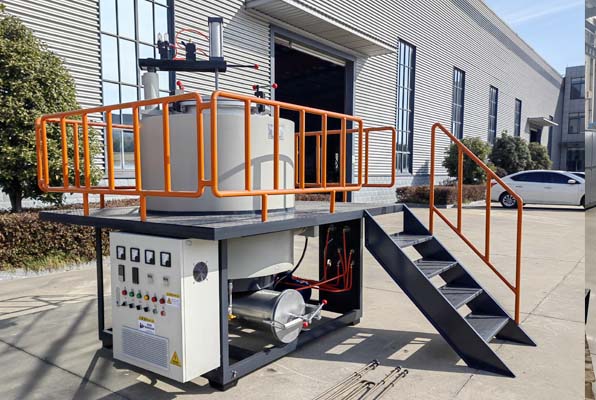In modern industrial production, especially in industries like chemical fiber, plastics, cables, and heat treatment, efficiently and environmentally cleaning oil stains and polymer residues from workpieces is a key challenge. Traditional incineration causes high pollution, while solvent cleaning is unsafe. Here, the Vertical Vacuum Cleaning Oven https://8ruiyan.com/en/all-vacuum-cleaning-furnaces/stands out as a star performer in the industrial cleaning field.
Today, let’s uncover the secrets of this equipment. We will see how it works and explore its outstanding features.

1. Core Components: A Precision “Cleaner”
As the name suggests, a Vertical Vacuum Cleaning Oven is placed vertically. This makes its structure compact and saves floor space. We can think of it as a powerful “intelligent cleaning oven”. It mainly consists of the following systems:
Oven System (“The Cleaning Workshop”)
- Furnace Shell and Inner Chamber: The outer layer is a sturdy insulated shell. The inner layer is a high-temperature resistant chamber (usually made of stainless steel). Together, they form a sealed heating space.
- Furnace Door: A seal door that opens from the top. It allows easy hoisting of workpieces and ensures a tight seal during operation.
- Baskets and Hangers: These hold the workpieces to be cleaned. They are typically made of heat-resistant stainless steel to prevent deformation under high temperatures.
Vacuum System (“Creating an Oxygen-Free Environment”)
- Vacuum Pump: A core component. It extracts air from the chamber to create a low-oxygen or oxygen-free environment. This is key to achieving oxidation-free cleaning.
- Vacuum Piping and Valves: Pipes connect the oven body to the vacuum pump. Precision valves control the gas flow.
- Vacuum Gauge: It monitors and displays the vacuum level inside the oven in real-time. This ensures accurate process parameters.
Heating System (“Providing Energy”)
- Heating Elements: Usually made of resistance wires or electric heating tubes. They are evenly arranged around the inner chamber to provide precise, controllable heat for the cleaning process.
- Temperature Controller: The brain of the system. It senses the internal temperature via thermocouples. It then precisely controls the heating power according to preset heating curves, enabling automated operation.
Control System (“The Smart Brain”)
- PLC and Touchscreen: Modern Vertical Vacuum Cleaning Ovens are equipped with intelligent control systems. Operators simply set parameters like temperature, time, and vacuum degree on the touchscreen. The equipment can then automatically complete the entire cleaning cycle and record historical data.
2. Working Principle: Four Steps to “Rebirth”
The cleaning process in a Vertical Vacuum Cleaning Oven is a sophisticated physico-chemical process. It mainly involves four steps:
- Evacuation: The basket containing workpieces is placed inside the oven. After closing the door, the vacuum pump is started to remove air from the chamber. This creates a low-oxygen environment to prevent workpiece oxidation at high temperatures.
- Heating and Cracking: The heating system is activated. It raises the temperature slowly according to a preset program. Under the combined effect of vacuum and high temperature (typically 400°C – 600°C), organic pollutants like oils and polymers on the workpiece surface rapidly vaporize or crack into small gas molecules.
- Volatilization and Exhaust: The gases and smoke produced by cracking are continuously pumped out of the oven by the running vacuum pump. This prevents pollutants from re-condensing on the workpiece surfaces.
- Cooling and Unloading: After the heating and cracking phase ends, the heating system shuts off. The oven cools down naturally. Finally, the door is opened, and the clean, like-new workpieces are taken out.
The entire process requires no chemical solvents. Pollutants are ultimately expelled as gases and can be collected for centralized treatment, making it very environmentally friendly.
3. Outstanding Features: Why Is It Highly Favored?
Compared to traditional cleaning methods, the Vertical Vacuum Cleaning Oven offers comprehensive advantages:
- Excellent Cleaning Results: In the vacuum environment, workpieces experience no oxidation or decarburization. They retain their original metallic luster and properties. The cleanliness rate can exceed 99.5%.
- High Efficiency and Energy Saving: The vertical structure utilizes natural upward heat convection. This ensures an even temperature field inside the oven and high thermal efficiency. High automation significantly reduces manual operation time.
- Safe and Environmentally Friendly: The entire process occurs in a sealed vacuum environment. There is no open flame or explosion risk. It does not produce harmful gases or wastewater, meeting modern industrial environmental standards.
- Easy Operation: PLC intelligent control allows for one-touch start-up and fully automated operation. This lowers the skill requirements for operators and ensures stable, repeatable processes.
- Wide Application Range: It is widely used for spinnerets and components in the chemical fiber industry, molds in the plastics industry, and various precision parts that need oil and organic residue removal.
- Extended Workpiece Lifespan: It avoids corrosion from acids, alkalis, and other chemical solvents, as well as high-temperature oxidation. This effectively extends the service life of the cleaned workpieces.
Заключение
The Vertical Vacuum Cleaning Oven is more than just a piece of equipment. It represents a modern industrial production philosophy that is efficient, clean, and intelligent. With its sophisticated structural design, scientific cleaning principles, and excellent overall performance, it is becoming the essential choice for more and more companies pursuing high quality, high efficiency, and sustainable development. On the stage of industrial cleaning, this “Oxygen-Free Cleaning Master” plays an irreplaceable role.
For further consultation, please contact our technical team for expert advice.
Whatsapp:86-19106101570
wechat:86-19106101570
email:fob@jsryan.com
